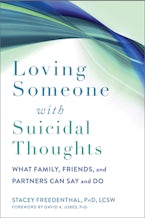By Stacey Freedenthal, PhD, LCSW, author of Loving Someone with Suicidal Thoughts
Many people believe once somebody makes up their mind to die by suicide, there’s nothing anyone can do to stop the person. Good news: That’s a myth. There are many things you can do to help someone with suicidal thoughts stay alive. Here are ten of them:
1. If you’re wondering if someone has suicidal thoughts, ask.
Many people are afraid asking about suicide plants the idea in someone’s mind or otherwise does harm. Not so, according to many research studies. Ask the question. You could say, “A lot of people who are going through a hard time have suicidal thoughts. Do you think of suicide?” If the person says no, ask if they’d tell you in the future if they had suicidal thoughts. And if they say no, they wouldn’t ever tell you, you now have an opportunity to learn why and potentially dispel their fears.
2. Avoid calling 911 unless it’s truly necessary.
Police involvement can be traumatic for someone already in distress, and an unnecessary call to 911 can inhibit someone from confiding in you again. Definitely call for emergency help if someone has a weapon in hand, has already made an attempt, or is in some other kind of immediate danger. If the person and you are both safe, invite them to tell you more about what they’re going through.
3. Listen bravely.
Brave listening is “resisting the temptation to change the subject, give advice, lecture, offer reassurance, or convince the person to think or feel differently. It’s focusing on the person’s needs, not on your own wish to feel less helpless, worried, and stressed as you listen,” as I discuss in my book, Loving Someone with Suicidal Thoughts.
In other words, brave listening means avoiding platitudes like “it gets better,” and “you have so much to live for,” or anything else that shuts the person down. There can be a time and place for such statements, but first it’s important to listen.
4. Give the person information about help available through hotlines, text lines, etc.
While hotlines often get a bad rap, most people who call later report it helped them. You, too, can call a hotline if you need advice on how to help someone. Calling 988 in the US will connect you to the 988 Suicide and Crisis Lifeline. (The long number is 800-273-TALK. They go to the same place.)
5. Encourage professional help.
So far, no treatment cures suicidal thoughts in everyone, but various psychotherapies—such as cognitive behavioral therapy (CBT), dialectical behavior therapy (DBT), and the Collaborative Assessment and Management of Suicidality (CAMS)—and medications (such as clozapine and lithium) have been linked to drops in suicidal thoughts and behaviors.
6. Maintain a safe environment.
One of the single most effective ways to prevent suicide is to get firearms out of reach. Merely having a firearm in the home increases a person’s risk for suicide. Also try to secure other dangerous items, such as pills.
7. Plan for safety.
Safety planning involves helping the person identify triggers of suicidal thoughts or other distress, people and places they can turn to for distraction, people and places who can help, and ways to keep their environment safe. According to multiple research studies, people who engage in safety planning tend to have lower rates of attempting suicide than those who don’t. A widely studied safety plan is available for free at www.suicidesafetyplan.com.
8. Generate hope, if possible.
Once you’ve bravely listened, help the person see possibilities that, at the moment, are outside of their awareness. To avoid invalidating or minimizing the person’s emotions, try to ask questions that can tap into the person’s own hope, rather than you merely stating things will get better. For example, you could ask the person, “What’s helped you get through hard times before?” or “How have you kept going with all this pain?” or “What are your reasons for staying alive so far?”
9. Stay connected.
Loneliness is linked to suicide. Maintaining contact with someone, by itself, can help reduce suicide risk when professionals reach out to patients and clients. There’s no reason to think that connection with friends and family isn’t also protective to some degree.
So, text the person you’re concerned about to see how they’re doing. Spend time together if they’re game. Offer to help with practical matters if you can, like chores or transportation. Small acts of kindness and care can have big results.
10. Take care of yourself.
You might think this is off-topic—how does taking care of yourself help someone else? The oxygen-on-the-airplane metaphor applies here: If you don’t attend to your own needs, you may struggle to stay present, listen bravely, and help out the person you’re worried about.
Suicide is not always preventable, but often it is. As I explain in another article, researchers tracked down people who were stopped from jumping off the Golden Gate Bridge. Even decades later, more than 90 percent hadn’t died by suicide.
The high survival rates of suicidal people in other studies also defy the myth that nothing can stop someone from ending their life. So, please, if you’re worried about someone, talk with the person, listen bravely, and do what you can to help while also taking care of yourself.
Stacey Freedenthal, PhD, LCSW, is a psychotherapist and consultant in private practice in Denver, CO; and associate professor at the University of Denver Graduate School of Social Work. Freedenthal focuses her work on helping people who experience suicidal thoughts or behavior. She authored Helping the Suicidal Person; and created the website, Speaking of Suicide.



 Part 2: What to Do When a Client Is Participating in Self-Judgment?
Part 2: What to Do When a Client Is Participating in Self-Judgment?